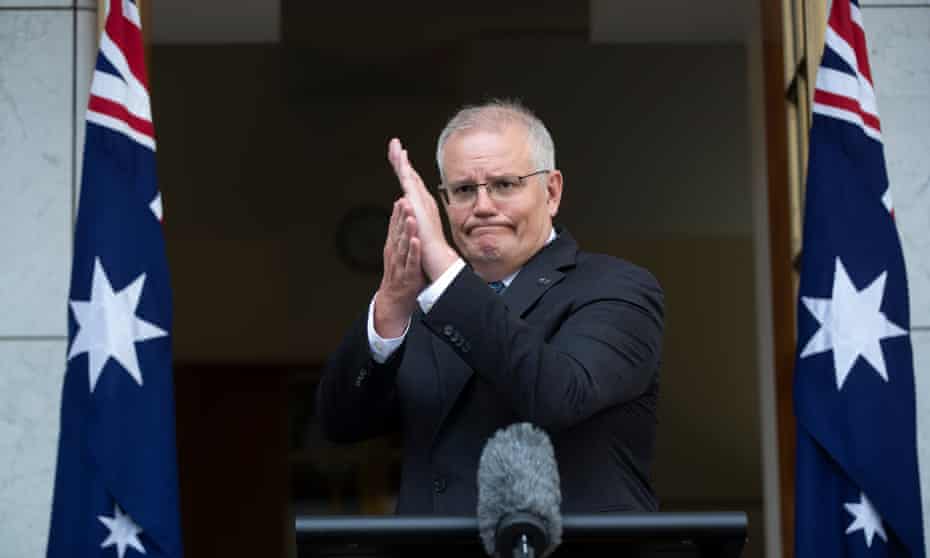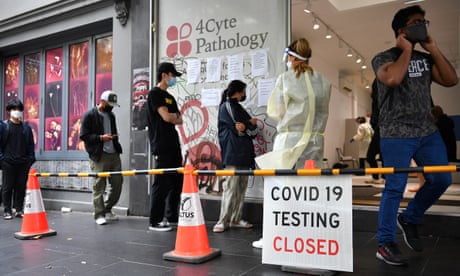Extract from The Guardian
In hindsight, opening up like we did seems nuts . As experts point out, you can’t run a healthy economy without healthy people.

It was good to see the prime minister kicking back at the cricket on Friday. Sends the right message.
Life goes on. The Poms are being hammered. How good?!
Another message was being sent by the nursing unit manager at Brisbane’s QEII Jubilee hospital. With 100 staff rendered unavailable by the outbreak, the manager’s advice to those remaining was to “Prioritise tasks…cry…whatever you need.”
In Queensland, some 2,000 healthcare staff are unable to work.
“This is like a crisis we’ve never seen before,” said Beth Mohle of the Queensland Nurses and Midwives Union. A view echoed by the Australian Medical Association’s Dr Maria Boulton: “We are in a crisis at the moment; the entire health care system is mobilising.”
And that’s just Queensland. And that’s just now.

New South Wales is running at more than 40,000 new cases a day. Those are official numbers, unlikely to capture the true extent of the spread – and even then they far surpass what seemed like alarmist warnings less than a month ago from the health minister, Brad Hazzard. Then, he spoke of 25,000 daily cases by the end of the January.
When the prime minister emerged from Wednesday’s national cabinet declaring schools would “go back and stay back (from) day one of term one”, it took just two days for that plan to crumble.
“We will not be sending primary school students back during the first week of school if we are heading towards a peak,” she said, foreshadowing further discussions at national cabinet level.
If teacher numbers are winnowed like nurses and truckies, it’s not clear how schools can stay open, let alone deliver normal classes.
Last October, Scott Morrison’s lamentations over the departure of premier Gladys Berejiklian were eased by the thought of her successor. Dominic Perrottet’s instincts were always strongly towards the “let it rip” school on Covid, views that aligned with the PM.
“A strong society needs a strong economy,” said Perrottet in his first speech as premier. He cited “opening up the economy” as a priority.
In mid-December, with Omicron already spreading and chief health officer Kerry Chant glowering behind him, Perrottet announced the dropping of mask and QR-code mandates outside “high-risk settings.”
In hindsight, it seems nuts. Even at the time, epidemiology professor Adrian Esterman declared: “It simply makes no sense.”
And then a weird thing happened. After the initial, expected rush back to bars and restaurants, Sydney folk went into swift retreat.
“Diners are spooked,” reported an ANZ Research paper this week. Nationally, consumer spending “is now at its worst since (the) Delta lockdowns”.
And the capital of the “let’s live with Covid” approach has been worst hit of all.
“Sydney spending for the week to 5 Jan was at its weakest since Covid began”, says the ANZ paper. “Caution about Omicron transmission and disruptions of businesses due to staff shortages are central to the decline.”
Workers who are sick or in forced isolation have disrupted supply chains so that supermarket shelves, especially for meat, fruit and vegetables, are increasingly bare. None of it is a surprise to economist Prof Jim Stanford.
“The idea that letting it rip – you know, taking a deep breath and puffing up our chest and just facing Covid head-on – would somehow be good for the economy, was always nonsense,” he said in a widely shared tweet. “You can’t run a healthy economy without healthy people.”
Faced with modelling showing NSW could find itself with barely a hospital bed to spare, in ICU or in general wards, by the end of January, at least a partial policy backflip was inevitable.
Perrottet says new bans will be enforced on singing and dancing in pubs and clubs. People have been asked to “minimise mingling”.
Non-urgent elective surgery will also be “paused”, to the frustration of many specialists.
“This is not just cosmetic surgery or minimal surgeries,” says Prof Jeff Dunn of the Prostate Cancer Foundation. “These are potentially life-saving or diagnostic surgeries.”
The modelling suggests the Omicron wave will begin to fall by mid-February. By the expected federal election in May, might the crisis be where Scott Morrison most wants to see it – in his beloved “rear-view mirror”?
Troy Bilsborough from the strategic consultancy Provocate is not so sure. A former health media adviser in the Abbott and Turnbull governments, Bilsborough says Covid is no longer a “theoretical” threat.
On official figures some 800,000 Australians have caught it. “Realistically, it is probably double that; it is probably up to 2 million,” says Bilsborough.
By the time people vote, he says, “you’re looking at another few million people”. Long Covid will be a lived experience for some. People will question if the government did enough to protect them. He predicts difficult new issues in industrial relations as workers seek clarity over time off for chronic symptoms.
His “gut feeling” is that the government might have been better placed “if they had kept a lid on the cases”.
Too late now.
But on the upside, we’re thrashing those Poms at the cricket.
No comments:
Post a Comment